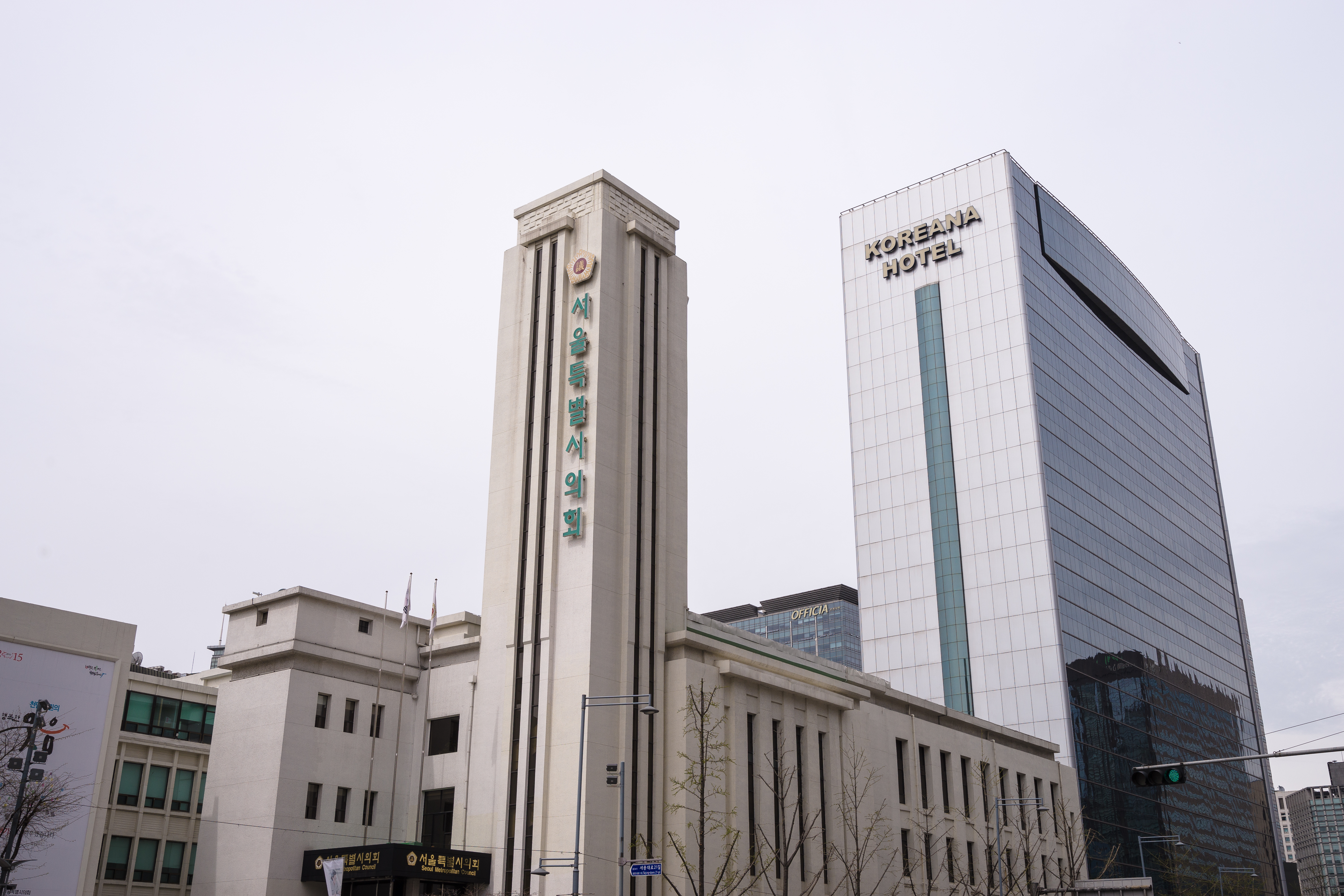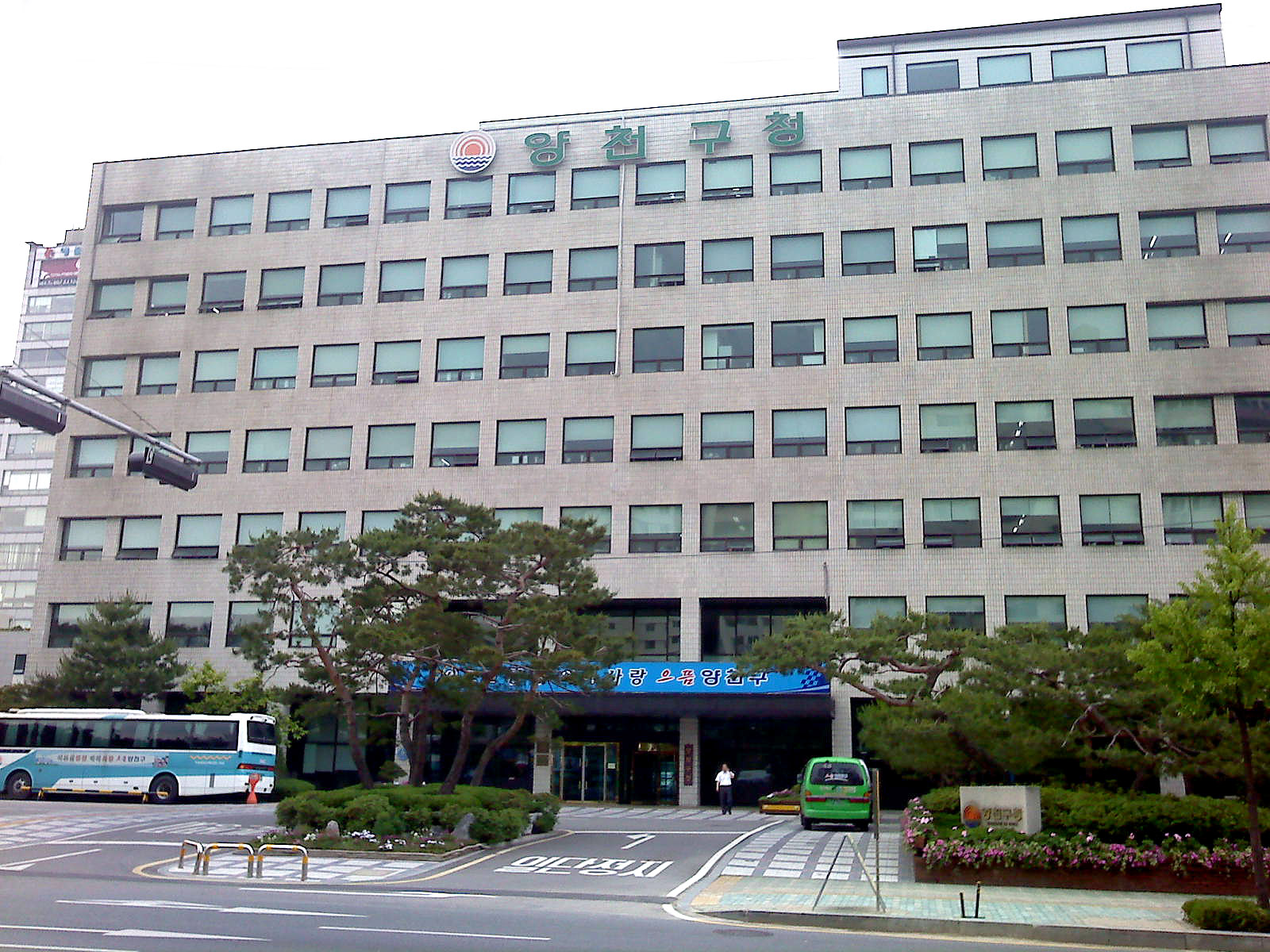|
Seoul Metropolitan Council
The Seoul Metropolitan Council () is the local council of Seoul. There are a total of 110 members, with 100 members elected in the First-past-the-post voting system and 10 members elected in Party-list proportional representation. Current composition Negotiation groups can be formed by 10 or more members. List of council members Organization The structure of Council consists of: *Chairman *Two Vice Chairmen *Standing Committees **Council Steering Committee **Administration & Autonomy Committee **Planning & Economy Committee **Environment & Water Resources Committee **Culture, Sports & Tourism Committee **Health & Social Affairs Committee **Public Safety & Construction Committee **City Planning & Management Committee **Transportation Committee **Education Committee *Special Committees **Special Committees on Budget & Accounts **Special Committees on Ethics Recent election results 2018 , - style="text-align:center;" ! rowspan="2" colspan="3" width="200" , Party ! ... [...More Info...] [...Related Items...] OR: [Wikipedia] [Google] [Baidu] |
Unicameralism
Unicameralism (from ''uni''- "one" + Latin ''camera'' "chamber") is a type of legislature, which consists of one house or assembly, that legislates and votes as one. Unicameral legislatures exist when there is no widely perceived need for multicameralism (two or more chambers). Many multicameral legislatures were created to give separate voices to different sectors of society. Multiple houses allowed, for example, for a guaranteed representation of different social classes (as in the Parliament of the United Kingdom or the French States-General). Sometimes, as in New Zealand and Denmark, unicameralism comes about through the abolition of one of two bicameral chambers, or, as in Sweden, through the merger of the two chambers into a single one, while in others a second chamber has never existed from the beginning. Rationale for unicameralism and criticism The principal advantage of a unicameral system is more efficient lawmaking, as the legislative process is simpler and there is ... [...More Info...] [...Related Items...] OR: [Wikipedia] [Google] [Baidu] |
Geumcheon District
Geumcheon District (Geumcheon-gu) is one of the 25 ''gu'' (districts) of Seoul, South Korea. It was created from southern parts of ''Guro-gu'' and tiny sections from Gwangmyeong in 1995. Its district office is located in front of Siheung Station, now Geumcheon-gu Office Station, in Siheung-dong. Geumcheon-gu is located in the southwest corner of the city, south of the Han River. It is bordered on the west by the Anyang River, and partially on the east by Gwanak Mountain, a dominating part of Seoul's southern skyline. Many technology companies are housed in Geumcheon-gu and several large headquarters are located here, albeit the income level of Seoulites here is lower than average. The Gyeongbu railway from Seoul Station to Busan station passes through, as well as Seoul Subway Lines 1 and 7. The mayor of this district has been Cha Sung-su (차성수) since July 2010. Administrative divisions *Gasan-dong (가산동 加山洞) *Doksan-dong (독산동 禿山洞) * Siheung-do ... [...More Info...] [...Related Items...] OR: [Wikipedia] [Google] [Baidu] |
Yeongdeungpo District
Yeongdeungpo District () is an administrative district in southwest Seoul, South Korea. Although the origin of the name is uncertain, the first two syllables are thought to be from "''yeongdeung''" (靈登) or "divine ascent", a shamanic rite. The third syllable is "''po''", representing the bank of a river (浦), referring to the district's position on the Han River. The 2006 population was 408,819. There are 22 administrative "dong" and 34 legal "dong". Yeouido-dong is the largest in area and takes up about 34% of the land. The total area is (2004), making up 4% of Seoul's land. The annual budget is approximately 2 billion won. Yeongdeungpo District has been heavily developed as an office, commercial, and residential district. Yeouido Dong is home to DLI 63 Building, the highest office building in South Korea and currently the 3rd tallest building in the country. The National Assembly Building is located in Yeouido-dong. Other organisations, such as the Financia ... [...More Info...] [...Related Items...] OR: [Wikipedia] [Google] [Baidu] |
Yangcheon District
The Yangcheon District (Yangcheon-gu) is a ''gu'', or district, of Seoul, South Korea, located on the southwest side of the Han River. At the centre of this district is the Mok-dong area, which is home to numerous shopping outlets, bars and restaurants, an ice rink, and large residential buildings inhabited by mostly upper-middle and upper-class families. Kim Soo-young of the Democratic Party was the district's first female mayor, which she served from July 2014 to June 2022. History It was known as 'Jechapaui-hyun' (제차파의현, 齊次巴衣縣) during the Goguryeo age, and has gone through several name-changes since. It was renamed 'Yangcheon' in 1310, during the Goryeo dynasty. It was separated from the neighboring Gangseo district in 1988. The Yangcheon District includes Mok-dong, Sinjeong-dong and Sinwol-dong. This area was developed during the 1980s, as a result of government policy to build a new residential area in Seoul; large apartment complexes were built. Now, ... [...More Info...] [...Related Items...] OR: [Wikipedia] [Google] [Baidu] |
Songpa District
Songpa-gu (Hangul: 송파구) is a ''Administrative divisions of South Korea#Gu (District), district'' of Seoul, South Korea. Previously known as Wiryeseong, the first capital of the kingdom of Baekje, Songpa is located in the southeastern part of Seoul, the capital city of South Korea. With roughly 647,000 residents, Songpa is also the largest district in Seoul by population. Songpa was at the center of 1988 Seoul Olympics, and most of the sports facilities associated with that event are located within the district. In 2009, Songpa was named one of the world's most livable cities at thLivCom Awardspresented by the United Nations Environment Programme. History Hanseong Baekje era (BC 18 ~ AD 660) In 18 BC, the kingdom of Baekje founded its capital city, Wiryeseong (위례성), in what is believed to be the modern-day Songpa District. Baekje subsequently developed from a member state of the Mahan confederacy into one of the Three Kingdoms of Korea. There are several city for ... [...More Info...] [...Related Items...] OR: [Wikipedia] [Google] [Baidu] |
Seongbuk District
Seongbuk District (Seongbuk-gu) is one of the 25 '' gu'' which make up the city of Seoul, South Korea. It is located in the mid-north part of the city. The current Mayor is Kim Young-bae (김영배), who has been mayor since July 1, 2010. Seongbuk-gu was established under Presidential Decree No. 159 on August 13, 1949 (including some areas of Dongdaemun-gu and some areas of Sungin-myeon, Goyang-gun), and was promoted to a autonomous district by implementing a Gu-level local government on May 1, 1988. In this district, more than 1,500 public officials are making every effort to realize a "closer neighborhood, happier neighborhood" in which the civic future value of balance, coexistence, and abundance is contained in the city. Administrative divisions Seongbuk District consists of 20 administrative dongs (haengjeong-dong, 행정동) and 39 legal dongs (beopjeong-dong, 법정동). *Anam-dong (안암동 安岩洞) * Bomun-dong (보문동 普門洞) *Donam-dong (돈암동 敦岩洞) ... [...More Info...] [...Related Items...] OR: [Wikipedia] [Google] [Baidu] |
Seongdong District
Seongdong District (Seongdong-gu) is one of the 25 '' gu'' which make up the city of Seoul, South Korea. It is situated on the north bank of the Han River. It is divided into 20 ''dong'' (neighbourhoods). Administrative divisions Seongdong District consists of 20 administrative dongs (haengjeong-dong, ) * Doseon-dong () ** Hongik-dong (): legal dong (beopjeong-dong, ) * Eungbong-dong () * Haengdang-dong () 1∼2 * Geumho-dong () 1∼4 * Majang-dong () * Oksu-dong () 1∼2 * Sageun-dong () * Seongsu 1ga 1 dong () * Seongsu 1ga 2 dong () * Seongsu 2ga 1-dong () * Seongsu 2ga 3-dong () * Songjeong-dong () * Yongdap-dong () * Wangsimni-dong () 1∼2 ** Sangwangsimni-dong (): legal dong (beopjeong-dong, ) ** Hawangsimni-dong (): legal dong (beopjeong-dong, ) Transportation Railways *KORAIL ;* Jungang Line ;;*(Dongdaemun-gu) ← Wangsimni ─ Eungbong ─ Oksu → (Yongsan-gu) ;*Bundang Line ;;* Wangsimni ─ Seoul Forest → (Gangnam-gu) *Seoul Metro ;* Seoul Undergroun ... [...More Info...] [...Related Items...] OR: [Wikipedia] [Google] [Baidu] |
Seocho District
Seocho District () is one of the 25 ''Administrative divisions of South Korea#Gu (District), gu'' (local government districts) which make up the city of Seoul, South Korea. Seocho is generally referred to as a part of Gangnam (Seoul), Greater Gangnam Area, along with Gangnam District. As of 2022, Seocho District ranks as the richest neighborhood in South Korea and among the most expensive areas in Seoul with an average sales price of 47.75 million South Korean won per 3.3 square meters. South Korea's rich are concentrated in the three Gangnam districts including Seocho, known as Gangnam School District Eight(강남 8학군). Seocho District is served by the Seoul Subway Line 2, Seoul Subway Line 3, Line 3, Seoul Subway Line 4, Line 4, Seoul Subway Line 7, Line 7, Bundang Line, Seoul Subway Line 9, Line 9, and Shinbundang Line. South Korea's longest highway, Gyeongbu Expressway, ends here. The most crowded area in Korea, Gangnam-daero Gangnam Station is located in Seocho District ... [...More Info...] [...Related Items...] OR: [Wikipedia] [Google] [Baidu] |
Seodaemun District
Seodaemun District (, "Great West Gate") is one of the 25 districts of Seoul, South Korea. Seodaemun has a population of 313,814 (2010) and has a geographic area of 17.61 km2 (6.8 sq mi), and is divided into 14 '' dong'' (administrative neighborhoods). Seodaemun is located in northwestern Seoul, bordering the city districts of Eunpyeong to the northwest, Mapo to the southwest, Jung to the southeast, and Jongno to the east. Seodaemun is part of the '' Seongjeosimni'' (Outer old Seoul) area and is named after Donuimun, one of the Eight Gates of Seoul which was formerly located within the district. Seodaemun is home to Seodaemun Independence Park, which contains several historic monuments and buildings such as the Seodaemun Prison museum and the Independence Gate. Moon Seok-Jin (문석진) of the Democratic Party has been the mayor of Seodaemun since July 2010. Administrative divisions Seodaemun District consists of 14 "administrative dong"s (''haengjeong-dong'' 행정동). ... [...More Info...] [...Related Items...] OR: [Wikipedia] [Google] [Baidu] |
Mapo District
Mapo District () is one of the 25 districts of Seoul, South Korea. Mapo has a population of 381,330 (2015) and has a geographic area of 23.87 km2 (9.22 sq mi), and is divided into 24 '' dong'' (administrative neighborhoods). Mapo is located in western Seoul on the northern bank of the Han River, bordering the Gyeonggi Province city of Goyang to the northwest, and the Seoul city districts of Gangseo to the west, Yeongdeungpo to the south, Yongsan to the southeast, Jung to the east, and Seodaemun and Eunpyeong to the north. Mapo is home to several universities and government buildings, and is well known for the Hongdae club district around Hongik University. Mapo is connected to the Seoul Metropolitan Subway's Line 2, Line 5, and Line 6, as well as the Airport Railroad, and the Korail Gyeongui-Jungang Line, which all pass through this district. The Seoul World Cup Stadium, a famous landmark in Seoul, is located in Sangam in northwest Mapo. Mapo District Office Location ... [...More Info...] [...Related Items...] OR: [Wikipedia] [Google] [Baidu] |
Dongjak District
Dongjak District (Dongjak-gu) is one of the 25 '' gu'' that make up the city of Seoul, South Korea. Its name was derived from the Dongjaegi Naruteo Ferry, on the Han River which borders the district to the north. It was the 17th ''gu'' created in Seoul, after being separated from Gwanak District on 1 April 1980. Administrative divisions Dongjak District is divided into 15 ''dong'': *Daebang-dong *Heukseok-dong (all of this dong was combined in January 2008) *Noryangjin-dong 1, 2 (Bon-dong was combined with Noryangjin 1-dong in September 2008) *Sadang-dong 1, 2, 3, 4, 5 (Dongjak-dong was combined with Sadang 2-dong in September 2008) *Sangdo-dong 1, 2, 3, 4 (2 and 5 dong were combined in January 2008) *Sindaebang-dong 1, 2 Education Dongjak District is home to Chongshin University, the Seoul campus of Chung-Ang University, and Soongsil University. Noryangjin-dong, especially near Noryangjin Station is known for private institutes or Hagwons, for college admission test an ... [...More Info...] [...Related Items...] OR: [Wikipedia] [Google] [Baidu] |



